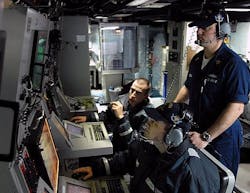ASSETT to apply artificial intelligence and machine autonomy to submarine combat systems
WASHINGTON, 13 Jan. 2017. U.S. Navy shipboard electronics experts need machine autonomy and artificial intelligence technology to improve effectiveness and reduce personnel requirements of surface ship and submarine combat systems. They found their solution from ASSETT Inc. in Manassas, Va.
Officials of the Naval Sea Systems Command in Washington announced plans Thursday to award a follow-on research contract to ASSETT for the Navy's Combat Systems of the Future (CSoF) project. The value of the contract has yet to be negotiated.
ASSETT engineers will develop an improved combat system that incorporates autonomous and remote vehicle command and control for to Navy submarines, surface ships, and aircraft.
ASSETT will provide cognitive engineering, systems engineering, modeling, simulation, software development, as well as hardware engineering, manufacturing, and support. The upcoming Small Business Innovative Research (SBIR) phase-3 contract has one base year and four one-year options.
ASSETT will capitalize on service-oriented architecture software design and artificial intelligence to design, test, and deploy technologies for the Navy's AN/BYG-1 submarine tactical control system.
Related: Siemens, Carnegie Mellon, and HRL pursue artificial intelligence to analyze images and text
The AN/BYG-1 handles weapons control aboard Navy Los Angeles-, Seawolf-, and Virginia-class fast-attack submarines, Ohio-class cruise missile submarines, the Australian Collins-class attack submarine, and the future Columbia-class ballistic missile submarine, which will replace existing Ohio-class ballistic missile submarines.
AN/BYG-1 improvements should help these submarines respond to new and emerging threats and use evolving technology for enhancements to Seal Delivery Vehicle (SDV) control displays; integrated bridge technology; command and control; and decision aids.
ASSETT, which is short for Advanced Systems/Supportability Engineering Technologies & Tools, won its original $14.6 million CSoF SBIR phase-3 contract in July 2010, and won an $11.4 million modification to that contract in December 2011.
The company's original CSoF work involved reduced shipboard manning requirements without compromising vessel safety and performance. Subsequent CSoF work involved operator cognition, automation, data fusion, processing, technology evolution, and combat systems technologies for Navy submarines, surface ships, and aircraft.
For more information contact ASSETT online at http://assett.net, or Naval Sea Systems Command at www.navsea.navy.mil.
Learn more: search the Aerospace & Defense Buyer's Guide for companies, new products, press releases, and videos

